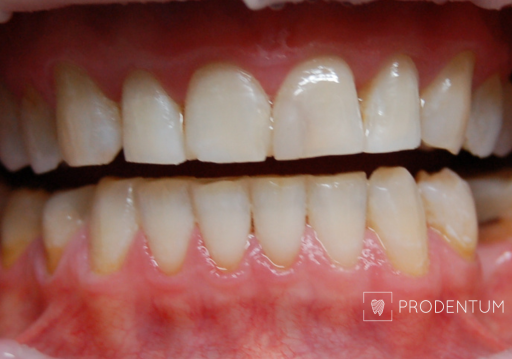
Effective tooth whitening
Tooth whitening procedures are performed to improve the appearance of the teeth. The procedure may be carried out on several teeth or all teeth.
Tooth whitening procedures are performed to improve the appearance of the teeth. The procedure may be carried out on several teeth or all teeth. There are two types of tooth whitening: in-office or at-home. A dentist’s examination is necessary before any tooth whitening can be done: the type of whitening is chosen depending on patient’s condition and wishes. Discolored teeth with treated root canals may be whitened internally. Professional tooth cleaning is necessary before tooth whitening procedures. Tooth whitening is performed only after evaluating the harms and benefits, and all safety measures are taken to protect teeth.
In case of certain discolorations (e.g., fluorosis), tooth whitening will not be effective. In those cases, a procedure called microabrasion is performed. The following tooth whitening procedures are performed in ProDentum clinic:
- Manufacturing of tooth whitening mouthguards;
- Tooth whitening using the Beyond whitening system
- Internal whitening;
- Microabrasion.
Tooth whitening using mouthguards
Impressions are taken and custom mouth guards are made in the dental laboratory. Whitening gel is put into the mouth guards, and they are worn on the teeth for a certain amount of time (according to the gel manufacturer’s instructions). Teeth may be whitened every day until you are satisfied with the result (no less than 2 weeks). If teeth become very sensitive, whitening can be done in intervals, e.g., every other day, or the gel may be held on the teeth for a shorter time.

Tooth whitening using Beyond whitening system
What is the Beyond whitening system?
BEYOND® Polus Power Whitening has been recognized as one of the safest tooth whitening systems in the world for 6 years in a row. More than 500 000 smiles were whitened using this whitening system. The new LightBridge™ whitening combines halogen and LED light into a light blue whitening light spectrum. It is an innovative technology with and advanced filtering system of 30 lenses covered with 150 000 optical layers to ensure the best protection against the heat of ultraviolet (UV) light for the tooth tissues. This system is a safe way to a fabulous smile in only 30 minutes.
You can see the procedure in this video:


Advantages:
- Rapid result – the preparation and the procedure itself takes up to 1.5 hours. The whitening process takes 30 to 40 minutes, i.e., three sessions 10 to 15 minutes each.
- Noticeable whitening effect – studies show that tooth whiteness increases by 5 to 6 steps in the VITA scale after whitening using the Beyond whitening system. Patients immediately notice result.
- Long lasting whiteness – teeth don’t go back to the previous darker shade even after some time.
- Safety – due to the optical filter, teeth and the adjacent tissues are protected against harmful ultraviolet and infrared rays. Beyond lamp generates cold light in a low temperature, minimizing tooth pulp irritation, which in turn results in less tooth sensitivity post treatment, usually unavoidable using regular tooth whitening systems.
Important:
- Increased sensitivity after the procedure usually disappears after several days.
- After tooth whitening, we recommend to avoid colorful fizzy drinks, food with coloring, and smoking.
- In order to ensure longevity of the whitening, we recommend additional whitening every 6 months with a mouth guard (once for 3 to 8 hours).
- Professional tooth cleaning is necessary before the laser tooth whitening procedure.
- If you follow these guidelines, you’ll be able to enjoy your white smile for a long time.


Tooth whitening using the “Beyond Polus” system


Tooth whitening using the “Beyond Polus” system
Internal non-vital tooth whitening
Tooth pulp in the root canal is made not only of nerves, but also blood vessels. When the tooth becomes non-vital due to a deep cavity, trauma or other causes, products of breaking down of blood and other tissues seep into dentin and the tooth becomes dark. When root canal treatment is done in a timely manner, tooth retains its natural color. Therefore it is very important to thoroughly clean all pulp tissues at the beginning of treatment. If it is not done, later on internal tooth whitening may be necessary.
First, the quality of the root canal treatment is evaluated, retreatment is done, if indicated. Then tooth fillings are taken out and whitening agent is put inside the tooth. Depending on materials used, internal tooth whitening is done in-office or the whitening agent is replaced once a week.
Internal whitening is done only for anterior teeth. Non-vital dark premolars and molars are usually restored prosthetically, firstly because the damaged tooth crown needs protecting. This also takes care of the discoloration.
Oral hygiene, tooth whitening price list
The cost is determined during consultation and may be adjusted during treatment.
Oral hygiene, tooth whitening price list
Name
of service
Price
Price
Prof. med.dr. V. Rutkūnas
Personal oral hygiene training
10,00€
€
Professional tooth cleaning
75,00€
€
Repeated professional tooth cleaning (after 2 to 4 weeks)
65,00€
€
Simple professional tooth cleaning (few remaining teeth)
50,00€
€
Tooth whitening using the Beyond system (both arches)
260,00€
€
Repeated tooth whitening (in 1 month, both arches)
180,00€
€
Whitening mouth guard (both arches + whitening agent)
350,00-450,00€
€
Whitening mouth guard (one arch + whitening agent)
180,00-240,00€
€
Whitening agent (1 syringe)
25,00-66,00€
€
Application of fluoride varnish or desensitization of exposed root
9,00-19,00€
€
Prescription of personal oral hygiene measures
8,00€
€
Polishing
15,00-50,00€
€
Frequently asked questions
Is tooth whitening painful?
Tooth whitening is not painful, but teeth may become sensitive during or after the treatment. Good thing that the sensitivity is temporary. If the teeth are very sensitive, some pain medicine may be taken. Your clinician will advise you on appropriate oral hygiene measures after tooth whitening.
Adverse effects:
- Increased sensitivity. It has been shown that changes to the dental pulp due to tooth whitening are reversible, therefore increased sensitivity is only temporary.
- Gum irritation. May happen due to a high-concentration whitening agent, using too much gel or keeping it too long.
- In very rare cases, external cervical resorption occurs after internal whitening. To prevent it, whitening agent is only put in the crown of the tooth, heat is no longer applied when whitening, and after whitening calcium hydroxide paste is used in the tooth for 2 weeks after whitening. It is also important to do follow-up X-rays once a year.
How long does the tooth whitening effect last and what does it depend on?
Your doctor will provide extensive recommendations for oral care to maintain the longevity of the results. The results of tooth whitening differ from patient to patient. On average, the whitening effect last for 1 to 2 years; however, the contributing factors are oral hygiene habits (it has been observed that patients that regularly come in for professional tooth cleaning have whiter teeth), diet (e.g., heavy use of coffee, tea or red wine). Heavy smokers should not expect long-lasting whitening effect. Studies show that yellowish to yellowish-orange teeth whiten better than greyish, bluish teeth.
To maintain the whitening effect, we recommend additional whitening once a year.
IMPORTANT!
- Professional tooth cleaning (because it is not possible to protect bleeding gums from the whitening agent) and cavity treatment is necessary before tooth whitening.
- Fillings and ceramic does not whiten, therefore restorations should be done only after whitening.
- At least 2 weeks should pass between the last whitening session and restorative work.
- In this time, all oxygen or peroxide breaks down in the tooth and the best adhesion between the filling and the tooth is ensured; also, tooth shade stabilizes, because the whitening effect continues for several days after the procedure.
- Tooth enamel is not damaged, as the tooth is not grinded or acid-etched.
- Tooth whitening for children younger than 18, pregnant and breastfeeding women is not recommended.
- For heavily tetracycline-stained teeth, more than a single procedure may be necessary.
Tooth whitening should be avoided while wearing braces. We recommend whitening teeth when the braces are taken off and professional tooth cleaning is done.
What about whitening toothpastes?
Most whitening toothpastes are very abrasive and aggressive, compared to regular toothpastes, therefore they remove more pigment stains and teeth look whiter. However, tooth enamel and dentin also wears away more quickly. Therefore, we do not recommend using whitening toothpaste, or limit it to once tube per year, and use such toothpaste intermittently.
Other recommended treatments
The ProDentum clinic has a wide range of services and provides patients with the highest level of professionalism.



